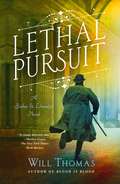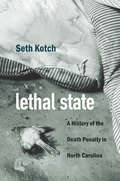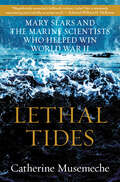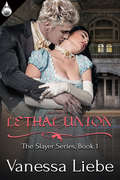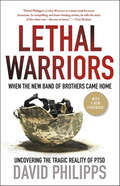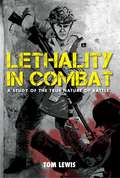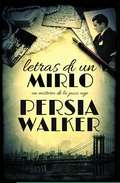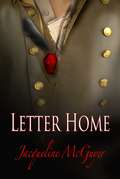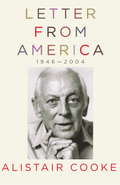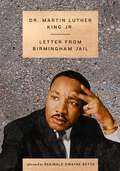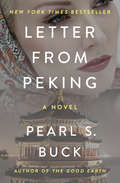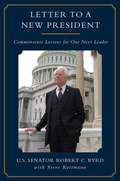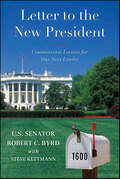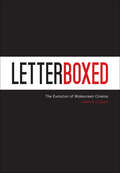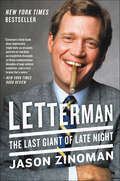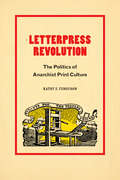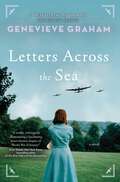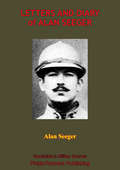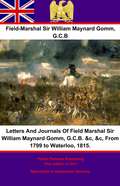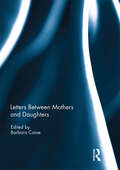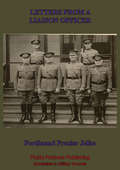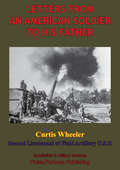- Table View
- List View
Lethal Pursuit: A Barker & Llewelyn Novel (A Barker & Llewelyn Novel #11)
by Will ThomasLondon, 1892—Cyrus Barker is brought into a game of international espionage by the Prime Minister himself in the newest mystery in Will Thomas's beloved series.Private enquiry agents Cyrus Barker and Thomas Llewelyn receive in the mail an unexplained key stamped with the letter Q. Barker, recognizing it for what it is, uses the key to unlock an anonymous door in the alleyway, which opens to an underground tunnel leading to Downing Street. The Prime Minister has a small task for Cyrus Barker. A Foreign Office agent stole a satchel in Eastern Europe, but was then himself murdered at Charing Cross. The satchel contains a document desperately wanted by the German government, but while the agent was killed, the satchel remains in English hands. With a cold war brewing between England and Germany, it's in England's interest to return the document contained in the satchel to its original owners and keep it out of German hands. The document is an unnamed first century gospel; the original owner is the Vatican. And the German government isn't the only group trying to get possession of it. With secret societies, government assassins, political groups, and shadowy figures of all sorts doing everything they can—attacks, murders, counter-attacks, and even massive street battles—to acquire the satchel and its contents, this small task might be beyond even the prodigious talents of Cyrus Barker.
Lethal State: A History of the Death Penalty in North Carolina (Justice, Power, and Politics)
by Seth KotchFor years, American states have tinkered with the machinery of death, seeking to align capital punishment with evolving social standards and public will. Against this backdrop, North Carolina had long stood out as a prolific executioner with harsh mandatory sentencing statutes. But as the state sought to remake its image as modern and business-progressive in the early twentieth century, the question of execution preoccupied lawmakers, reformers, and state boosters alike.In this book, Seth Kotch recounts the history of the death penalty in North Carolina from its colonial origins to the present. He tracks the attempts to reform and sanitize the administration of death in a state as dedicated to its image as it was to rigid racial hierarchies. Through this lens, Lethal State helps explain not only Americans' deep and growing uncertainty about the death penalty but also their commitment to it. Kotch argues that Jim Crow justice continued to reign in the guise of a modernizing, orderly state and offers essential insight into the relationship between race, violence, and power in North Carolina. The history of capital punishment in North Carolina, as in other states wrestling with similar issues, emerges as one of state-building through lethal punishment.
Lethal Tides: Mary Sears and the Marine Scientists Who Helped Win World War II
by Catherine Musemeche"Magnificently researched, brilliantly written, Lethal Tides is immensely entertaining and reads like an action novel. Catherine Musemeche has brought to life the incredible work of the scientists and researchers who made such a remarkable contribution to America’s war effort in the Pacific theater during WWII.” —Admiral William H. McRaven (U.S. Navy, Ret.), #1 New York Times bestselling author of Make Your Bed and The Hero CodeLethal Tides tells the story of the virtually unknown Mary Sears, “the first oceanographer of the Navy,” whose groundbreaking oceanographic research led the U.S. to victory in the Pacific theater during World War II. In Lethal Tides, Catherine Musemeche weaves together science, biography, and military history in the compelling story of an unsung woman who had a dramatic effect on the U.S. Navy’s success against Japan in WWII, creating an intelligence-gathering juggernaut based on the new science of oceanography. When World War II began, the U.S. Navy was unprepared to enact its island-hopping strategy to reach Japan. Anticipating tides, planning for coral reefs, and preparing for enemy fire was new ground for them, and with lives at stake it was ground that had to be covered quickly. Mary Sears, a marine biologist, was the untapped talent they turned to, and she along with a team of quirky marine scientists were instrumental in turning the tide of the war in the United States’ favor.The Sears team analyzed ocean currents, made wave and tide predictions, identified zones of bioluminescence, mapped deep-water levels where submarines could hide and gathered information about the topography and surf conditions surrounding the Pacific islands and Japan. Sears was frequently called upon to make middle-of-the-night calculations for last-minute top-secret landing destinations and boldly predicted optimal landing times and locations for amphibious invasions.In supplying these crucial details, Sears and her team played a major role in averting catastrophes that plagued earlier amphibious landings, like the disastrous Tarawa, and cleared a path to Okinawa, the last major battle of World War II.
Lethal Union
by Vanessa LiebeA debutante by day, slayer of demons and vampires by night ... life is very complicated for Sarah Carlton. It gets even more complicated as she tries to fight her growing passion for a Master Vampire, the Marques of Sanford. A forbidden attraction between deadly arch enemies ... Vanessa Liebe brings Regency England to life in Lethal Union, Book 1 of Slayer, her new paranormal romance series.Sarah Carlton is a debutante in Regency England and she is also "The Slayer." She has the difficult task of balancing her life between the social whirl of the haut ton and slaying demons and the undead at night. To complicate her life further, Sarah knows a Master Vampire is coming to London - a vampire she has been ordered to capture rather than kill. But nothing prepares her for the Marquis of Sandford, or her attraction to him.Dominic, the Marquis of Sandford, has come to London after hearing of the Slayer. Believing her previously to only be a myth, he's curious to meet her and fight her - he's not expecting to desire her and start wanting something else entirely. Then she is kidnapped just as he has convinced her to be with him. Can he rescue her in time?Content Notes: Hot, Exhibitionism, Voyeurism, Light BDSM, Non-Sexual Physical Assault, Fantasy, Paranormal, Regency, Action, Adventure, Demons, Vampires
Lethal Warriors: When the New Band of Brothers Came Home
by David PhilippsPulitzer Prize finalist David Philipps brings to life the chilling story of how today's American heroes are slipping through the fingers of society—with multiple tours of duty and inadequate mental-health support creating a crisis of PTSD and a large-scale failure of veterans to reintegrate into society.Following the frightening narrative of the 506th Infantry Regiment—who had rebranded themselves as the Lethal Warriors after decades as the Band of Brothers—he reveals how the painful realities of war have multiplied in recent years, with tragic outcomes for America's soldiers, compounded by an indifferent government and a shrinking societal safety net.
Lethality in Combat: A Study of the True Nature of Battle
by Doctor Tom LewisLethality in Combat shines a blazing light on the three most controversial aspects of military combat: the necessity of killing; the taking, or not, of prisoners; and the targeting of civilians. This book argues that when a nation-state sends its soldiers to fight, the state must accept the full implications of this, uncomfortable as they may be. Drawing on seven conflicts - the Boer War, World Wars I and II, and the wars in Korea, Vietnam, the Falklands and Iraq - the author considers these ethical issues.
Letras americanas: Roth y DeLillo
by David RemnickNacidos con apenas tres años de diferencia, Philip Roth (1933) y Don DeLillo (1936) son dos glorias vivas de las letras americanas que han sido retratados por la ágil pluma de David Remnick. Pocos escritores concitan tanta unanimidad como el estadounidense Philip Roth. Uno de los novelistas fundamentales de los últimos cincuenta años, fue el primer escritor vivo publicado en la Library of America. En este extraordinario perfil, Remnick repasa las obras maestras de Roth, la polémica que acompañó sus inicios tras la publicación de El lamento de Portnoy, la depresión que a mediados de los 90 le llevó a refugiarse en la literatura y las opiniones de Roth sobre el futuro de la literatura y las raíces de su arte.Si Roth es el escritor público, que se crece ante la hostilidad, Don DeLillo es el autor huidizo, que intenta evitar la exposición pública. Sin embargo, su obra, con cumbres como Submundo, o Libra le ha convertido en uno de los novelistas más prestigiosos de la actualidad. Remnick va en su busca a un pueblecito cercano a Nueva York y le acompaña en un paseo por su barrio natal para buscar los temas y las preocupaciones que marcan sus novelas.
Letras de un Mirlo: Un Misterio del Jazz Age
by Persia Walker"Un misterio de asesinato ambientado entre la burguesía negra, es también la historia embriagadora de una época pasada... intriga familiar y convincente y un retrato lleno y vibrante de esa era histórica cuando el pulso de Harlem era el ritmo de la América negra.” —El Boston Globe "Tanto una historia de mentiras, engaños y asesinatos como un comentario sobre raza y clase...” —Chicago Tribune Viejos amores, odios enconados y secretos familiares enterrados: un hombre regresa de la muerte en esta historia de la Nueva York de 1920. David McKay desapareció hace años mientras investigaba un linchamiento. Ahora está de vuelta, muy vivo y decidido a encontrar la verdad detrás de la brutal muerte de su hermana. Su búsqueda descubre el telón del reluciente mundo del renacimiento de Harlem para revelar un mundo de mentiras, hipocresía y traición trágica. Cada día que pasa en la ciudad lo acerca a la verdad, y más cerca de la ruina. ¿Qué tan pronto antes de que acabe el tiempo? ¿Qué tan pronto antes de que sus enemigos descubran su propia vergüenza secreta, el pecado que podría destruirlo? La letra de un mirlo es un absorbente y poderoso autónomo en la serie de misterios noir de 1920 de Persia Walker. Una historia tensa de no correspondido, evoca la mística de la era más fascinante de Harlem.
Letter Home
by Jacqueline McGuyerAfter leaving seminary in Scotland against his father's wishes, a young boy lands on the shores of America in 1859. In 1861, he gives up his British protection and with six of his friends, joins the Confederate Army. The boy marches for months through mud and rain, travels standing shoulder-to-shoulder in crowded trains. They take rear guard so often they call themselves the DRAG—Damn Rear Ass Guard. A Yankee bullet explodes in his left ankle at The Battle of Seven Pines. The doctor takes his left leg in Richmond Virginia. He's a man now, he takes a wife. An explosion at Browns Island Laboratory takes the son of his wife's best friend. The army takes her friend to jail for instigating the Richmond Bread Riots. He takes his wife home to Texas. After building his church, He must now decide his fate as a pastor, husband, father and son. Will the mail finally take William Copeland's Letter Home to Scotland?
Letter from America, 1946-2004
by Alistair CookeFor over half a century, Alistair Cooke entertained and informed millions of listeners around the world in his weekly BBC radio program Letter from America. An outstanding observer of the American scene, he became one of the world's best-loved broadcasters, and a foreigner who helped Americans better understand themselves. Here, in print for the first time, is a collection of Cooke's finest reports that celebrates the inimitable style of this wise and avuncular reporter. Beginning with his first letter in 1946, a powerful description of American GIs returning home, and ending with his last broadcast in February 2004, in which he expressed his views on the United States presidential campaign, the collection captures Cooke's unique voice and gift for telling stories. Gathered in this volume are encounters with the many presidents Cooke knew, from Roosevelt to Nixon, Reagan, Clinton, and Bush, both Senior and Junior. His friends are warmly recollected-among them Leonard Bernstein, Philip Larkin, Humphrey Bogart, Charlie Chaplin, and Katharine Hepburn. We observe a variety of political landmarks-the Vietnam War, Watergate, Cooke's remarkable eyewitness account of Robert Kennedy's assassination, through to the scandals that surrounded Clinton and the conflict in Iraq. His moving evocation of the events of September 11 and its aftermath remains essential reading, while his recollections of holidays and sporting events remind us of Cooke's delight in the pleasures of everyday life. Imbued with Alistair Cooke's good humor, elegance, and understanding, Letter from America, 1946--2004 is a captivating insight into the heart of a nation and a fitting tribute to the man who was for so many the most reassuring voice of our times. From the Hardcover edition.
Letter from Birmingham Jail
by Martin Luther King Jr.During the struggle for civil rights in the 1960s, Martin Luther King emerged as the movement's most eloquent leader. The two selections here testify to the emotional and logical power of his arguments. In "Letter from Birmingham Jail," King explains why blacks can no longer be prisoners of inequality. His "I Have a Dream" speech, delivered to 250,000 civil rights marchers in 1963, is another moving appeal for equality.
Letter from Birmingham Jail (The Essential Speeches of Dr. Martin Lut)
by Dr. Martin Luther King Jr.A beautiful commemorative edition of Dr. Martin Luther King's essay "Letter from Birmingham Jail,” part of Dr. King's archives published exclusively by HarperCollins.With an afterword by Reginald Dwayne Betts On April 16, 1923, Dr. Martin Luther King Jr., responded to an open letter written and published by eight white clergyman admonishing the civil rights demonstrations happening in Birmingham, Alabama. Dr. King drafted his seminal response on scraps of paper smuggled into jail. King criticizes his detractors for caring more about order than justice, defends nonviolent protests, and argues for the moral responsibility to obey just laws while disobeying unjust ones."Letter from Birmingham Jail" proclaims a message - confronting any injustice is an acceptable and righteous reason for civil disobedience.This beautifully designed edition presents Dr. King’s speech in its entirety, paying tribute to this extraordinary leader and his immeasurable contribution, and inspiring a new generation of activists dedicated to carrying on the fight for justice and equality.
Letter from Peking: A Novel (Los Jet De Plaza Y J Series)
by Pearl S. BuckFrom the Nobel Prize–winning author of The Good Earth: The New York Times–bestselling novel of a Chinese-American family separated by war. Elizabeth and Gerald MacLeod are happily married in China, bringing up their young son, Rennie. But when war breaks out with Japan, Gerald, who is half-Chinese, decides to send his wife and son back to America while he stays behind. In Vermont, Elizabeth longingly awaits his letters, but the Communists have forbidden him from sending international mail. Over time, both the silences and complications grow more painful: Gerald has taken up a new love and teenager Rennie struggles with his mixed-race heritage in America. Rich with Buck&’s characteristic emotional wisdom, Letter from Peking focuses on the ordeal of a family split apart by race and history. This ebook features an illustrated biography of Pearl S. Buck including rare images from the author&’s estate.
Letter to a New President: Commonsense Lessons for Our Next Leader
by Robert C. Byrd Steve Kettmann[From Jacket] "In 'Letter to a New President,' Byrd recounts lessons drawn from his remarkable life as a young boy growing up poor in the coalfields of southern West Virginia to his meteoric rise to the pinnacles of power in Washington, D.C. Byrd focuses his observations on underappreciated and seldom discussed virtues like personal responsibility, careful consideration before making decisions, and a sense of decency and fairness even toward fierce opponents. A student of history and a defender of our Constitution, Byrd looks to the past for lessons and, in 'Letter to a New President,' studies present failures as guides for constructive lessons for the future."
Letter to the New President: Commonsense Lessons for Our Next Leader
by Robert C. Byrd Steve KettmannA legendary Senator advises our next President on the commonsense values necessary to lead our nationUnited States Senator Robert C. Byrd is the longest-serving member of the United States Senate in the history of our great Republic. Senator Byrd has served the people of West Virginia, and the nation, for fifty-four years, and has served alongside eleven Presidents. He was twice elected by his colleagues to the position of Senate Majority Leader and currently is chairman of the powerful Senate Appropriations Committee. Byrd has lived through two world wars, the Great Depression, the civil rights movement, the Cold War, the resignation of a U.S. President, the 9/11 terrorist attacks, and traumatic military conflicts around the globe, including Iraq and Vietnam. Byrd has been a witness to it all. And now, in his ninetieth year of life, he wants to share the commonsense lessons he has learned from his unique vantage point in history.In Letter to a New President, Byrd recounts lessons drawn from his remarkable life as a young boy growing up poor in the coalfields of southern West Virginia to his meteoric rise to the pinnacles of power in Washington, D.C. From his unique vantage point in history, Byrd focuses his observations on underappreciated and seldom discussed virtues like personal responsibility, careful consideration before making decisions, and a sense of decency and fairness even toward fierce opponents. A student of history and a defender of our Constitution, Byrd looks to the past for lessons and, in Letter to a New President, studies present failures as guides for constructive lessons for the future.This book will help the next President grapple with the heavy demands of the office. Every American who cares about where this country is heading will find rich wisdom in Byrd's sage advice.Enlightened by a wide-ranging knowledge of American history and a love for the guiding principles of the Constitution, Byrd's observations sharpen the focus of the historical moment in which we find ourselves, as no one but Senator Byrd can.
Letterboxed: The Evolution of Widescreen Cinema
by Harper CossarWhen widescreen technology was introduced to filmmaking in 1953, it changed the visual framework and aesthetic qualities of cinema forever. Before widescreen, a director's vision for capturing beautiful landscapes or city skylines was limited by what coul
Lettering Young Readers in the Dutch Enlightenment: Literacy, Agency and Progress in Eighteenth-Century Children’s Books (Palgrave Studies in the History of Childhood)
by Feike Dietz'This book presents a rigorous, hugely informative analysis of the early history of Dutch children’s literature, pedagogical developments and emerging family formations. Thoroughly researched, Dietz’s study will be essential for historians of eighteenth-century childhood, education and children’s books, both in the Dutch context and more widely.’— Matthew Grenby, Newcastle University, UK. ‘A rich, informative, well-documented and effectively illustrated discussion of the ways Dutch eighteenth-century educators tried to transform youth into responsible readers. It does so in a wide international context and masterfully connects this process to the radical politicization and de-politicization of Dutch society in the revolutionary period.’—Wijnand W. Mijnhard, formerly of Utrecht University, the Netherlands, and theUniversity of California at Los Angeles, USA.This book explores how children’s literature and literacy could at once regulate and empower young people in the eighteenth-century Dutch Republic. Rather than presenting the history of childhood as a linear story of increasing agency, it suggests that we view it as a continuous struggle with the impossibility of full agency for young people. This volume demonstrates how this struggle informed the production of books in a historical context in which the development of independent youths was high on the political agenda. In close interaction with international children’s literature markets, Dutch authors developed new strategies to make the members of young generations into capable readers and writers, equipped to organize their own minds and bodies properly, and to support a supposedly declining fatherland.
Letterman: The Last Giant of Late Night
by Jason ZinomanNew York Times comedy critic Jason Zinoman delivers the definitive story of the life and artistic legacy of David Letterman, the greatest television talk show host of all time and the signature comedic voice of a generation.In a career spanning more than thirty years, David Letterman redefined the modern talk show with an ironic comic style that transcended traditional television. While he remains one of the most famous stars in America, he is a remote, even reclusive, figure whose career is widely misunderstood. In Letterman, Jason Zinoman, the first comedy critic in the history of the New York Times, mixes groundbreaking reporting with unprecedented access and probing critical analysis to explain the unique entertainer’s titanic legacy. Moving from his early days in Indiana to his retirement, Zinoman goes behind the scenes of Letterman’s television career to illuminate the origins of his revolutionary comedy, its overlooked influences, and how his work intersects with and reveals his famously eccentric personality. Zinoman argues that Letterman had three great artistic periods, each distinct and part of his evolution. As he examines key broadcasting moments—"Stupid Pet Tricks" and other captivating segments that defined Late Night with David Letterman—he illuminates Letterman’s relationship to his writers, and in particular, the show’s co-creator, Merrill Markoe, with whom Letterman shared a long professional and personal connection.To understand popular culture today, it’s necessary to understand David Letterman. With this revealing biography, Zinoman offers a perceptive analysis of the man and the artist whose ironic voice and caustic meta-humor was critical to an entire generation of comedians and viewers—and whose singular style ushered in new tropes that have become clichés in comedy today.
Letterpress Revolution: The Politics of Anarchist Print Culture
by Kathy E. FergusonWhile the stock image of the anarchist as a masked bomber or brick thrower prevails in the public eye, a more representative figure should be a printer at a printing press. In Letterpress Revolution, Kathy E. Ferguson explores the importance of printers, whose materials galvanized anarchist movements across the United States and Great Britain from the late nineteenth century to the 1940s. Ferguson shows how printers—whether working at presses in homes, offices, or community centers—arranged text, ink, images, graphic markers, and blank space within the architecture of the page. Printers' extensive correspondence with fellow anarchists and the radical ideas they published created dynamic and entangled networks that brought the decentralized anarchist movements together. Printers and presses did more than report on the movement; they were constitutive of it, and their vitality in anarchist communities helps explain anarchism’s remarkable persistence in the face of continuous harassment, arrest, assault, deportation, and exile. By inquiring into the political, material, and aesthetic practices of anarchist print culture, Ferguson points to possible methods for cultivating contemporary political resistance.
Letters Across the Sea
by Genevieve GrahamInspired by a little-known chapter of World War II history, a young Protestant girl and her Jewish neighbour are caught up in the terrible wave of hate sweeping the globe on the eve of war in this powerful love story that&’s perfect for fans of The Guernsey Literary and Potato Peel Pie Society.If you&’re reading this letter, that means I&’m dead. I had obviously hoped to see you again, to explain in person, but fate had other plans. 1933 At eighteen years old, Molly Ryan dreams of becoming a journalist, but instead she spends her days working any job she can to help her family through the Depression crippling her city. The one bright spot in her life is watching baseball with her best friend, Hannah Dreyfus, and sneaking glances at Hannah&’s handsome older brother, Max. But as the summer unfolds, more and more of Hitler&’s hateful ideas cross the sea and &“Swastika Clubs&” and &“No Jews Allowed&” signs spring up around Toronto, a city already simmering with mass unemployment, protests, and unrest. When tensions between the Irish and Jewish communities erupt in a riot one smouldering day in August, Molly and Max are caught in the middle, with devastating consequences for both their families. 1939 Six years later, the Depression has eased and Molly is a reporter at her local paper. But a new war is on the horizon, putting everyone she cares about most in peril. As letters trickle in from overseas, Molly is forced to confront what happened all those years ago, but is it too late to make things right? From the desperate streets of Toronto to the embattled shores of Hong Kong, Letters Across the Sea is a poignant novel about the enduring power of love to cross dangerous divides even in the darkest of times—from the #1 bestselling author of The Forgotten Home Child.
Letters And Diary Of Alan Seeger
by Alan Seeger"I HAVE a rendezvous with DeathAt some disputed barricade,When Spring comes back with rustling shadeAnd apple-blossoms fill the airI have a rendezvous with DeathWhen Spring brings back blue days and fair"The above unfortunately prophetic lines were written by the famed war poet Alan Seeger months before his death at the hands of German fire during the infamous slaughter of the battle of the Somme whilst serving in the French Foreign Legion. He saw a great deal of fighting in his two years with the French, indeed some of the worst of it as the Legion was posted many times to the most exposed parts of the lines. His diary entries are a strange mixture of his service under heavy fire with his common fellow poilus, which he faced so stoically despite having a heavy premonition of his own death, and his poetic insights into daily life.Well-known and well-liked by his colleagues they set about collecting his notes and poems into this memorial volume to commemorate his achievements in the French army and his literary attainments.
Letters And Journals Of Field Marshal Sir William Maynard Gomm, G.C.B. &c, &c, From 1799 to Waterloo, 1815.
by Field-Marshal Sir William Maynard Gomm G.C.BThis ebook is purpose built and is proof-read and re-type set from the original to provide an outstanding experience of reflowing text for an ebook reader. Field-Marshal Gomm's letters and journals provide a first-rate account of the numerous actions, battles and events that he was involved in during the Napoleonic wars. A seasoned officer from a military family, he was an acute observer of all that went on around him, and the notes and letters he wrote, edited by his son, provide a capital trove of information. This collection of his diary entries and letters focuses on the Napoleonic Wars, although he would rise to the highest rank in the British Army and C-in-C of India. Engaged in the early campaigns of the British Army against the French forces from 1799, he was one of the few officers that fought in the Peninsular War and the Waterloo campaign that actually had some staff training, having passed through Staff College. Many of his contemporaries were somewhat amateur in their outlook to soldiering, but Gomm was a thoughtful and assiduously thorough officer. After the campaign in Portugal and Spain, first under Wellington and then under Sir John Moore, he managed to survive the Walcheren expedition and was then posted back to Spain, where he would serve out the Peninsular war. Present at the battles of Busaco, Fuentes d'Oñoro, Salamanca, Vittoria, the Pyrenees, the Nive, the Nivelle and St Pierre, as well as the sieges of Cuidad Rodrigo and Badajoz, he was a lieutenant-colonel by the time he left for England. This was a fairly rapid ascent for the time, a signal confirmation of his abilities as a staff and regimental officer, and some influence at home, no doubt. Appointed to the post of Quartermaster General of Picton's fifth division, he was to see the furious combat of Quatre Bras and the "hard pounding" of Waterloo two days later. His position as an unattached staff officer gave him a view of the fields of battle from a position on horseback, and with freedom of movement around the field that few could match. His contemporaneous notes and letters of Waterloo are annotated with his more considered thoughts and views, particularly regarding the "crisis" of Waterloo, the repulse of the last columns of the Garde Impèriale. Text taken, whole and complete from the 1881 edition, John Murray, London. Original -438 pages Author - Field-Marshal Sir William Maynard Gomm, G.C.B (1784-1875) Editor - Francis Culling Carr-Gomm (1834-1919) Introduction - Francis Culling Carr-Gomm (1834-1919) Illustrations - 1 Portrait Linked TOC.
Letters Between Mothers and Daughters
by Barbara CaineThere are now many studies of family letters in Europe, but most of them focus on marital letters and letters between parents, especially mothers, and their sons. Little attention has been paid to the letters to and from daughters. This volume seeks to begin filling that gap by exploring the continuities and changes evident in the letters written between mothers and daughters over several centuries. Some of these changes reflect the history of letters and the ways that they were written and delivered, especially the move from the use of scribes and couriers in the medieval and early modern period, which made both the writing and reading of letters a public affair, to the use of pens and the situation in which letters were able to be written in private and read only by the person to whom they were addressed. But the letters also reveal the changing nature of the mother and daughter relationship, as the formal and more distant ties evident in the early period, in which dynastic and other matters were often more important to a mother than her daughter’s personal happiness, were replaced by closer and more intimate ties and a concern with particular personalities and individual needs. This book was originally published as a special issue of Women’s History Review.
Letters From A Liasion Officer
by Captain Ferdinand Frazier JelkeIt goes without saying that the letters here gathered were not written with any idea of being permanently preserved. They were merely a progressive recital, in a most informal and unstudied vein, of circumstances and scenes with which the writer came in touch in the course of his work, first in the ranks of the Marine Corps, and afterward as a Lieutenant of Infantry in the Liaison Service, in France.But since the author's return from "Over There"--and in view of the gigantic scale of World War and the epochal character of the events and situations touched upon in the correspondence--members of his family have urged that the series of letters written from the scenes of his activities during 1917-'19, be made into a handy volume for the use of such friends as may find in them some personal appeal and interest.In preparing the letters for publication an attempt has been made to omit the more private and intimate details, while retaining such of the descriptive text as would aid the reader in gaining some lasting impressions of the scenes and incidents which rushed by, like an animated panorama, in those days of frenzied endeavour and kaleidoscopic change, beginning shortly after America's entrance into the war and continuing until after the signing of the Armistice, and the return of the writer to America, early in 1919.
Letters From An American Soldier To His Father, By Curtis Wheeler, Second Lieutenant Of Field, Artillery, U. S. R.
by Second Lieutenant Curtis WheelerLieutenant Wheeler was one of the contingent selected from the first Plattsburg camp to be sent abroad for three months' study, close up, of modern warfare. Prior to his Plattsburg experience he had spent four months on the Texas border in Battery C of the First Illinois Field Artillery. Before that, while a student at Yale (class of 1911), he had joined a troop of cavalry then in. training in New Haven, maintaining his connection with it for two years while still pursuing his academic course.These letters were written with no thought in the mind of the writer of their being published. The personal note is obvious in them and no attempt has been made to edit it out. The editing, in fact, has been of the slightest. About all that has been done is to give initials in place of names where persons are mentioned by name, to give a heading to each letter, and to eliminate here and there a personal reference that would be blind to the reader. Otherwise the letters are just as written-the fresh, spontaneous, unconstrained narrative of personal experiences that link themselves up closely to a million American homes from which boys have gone to prepare themselves for similar experiences.
